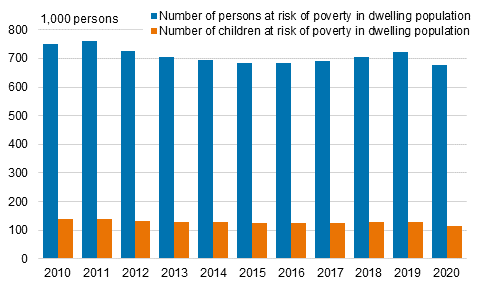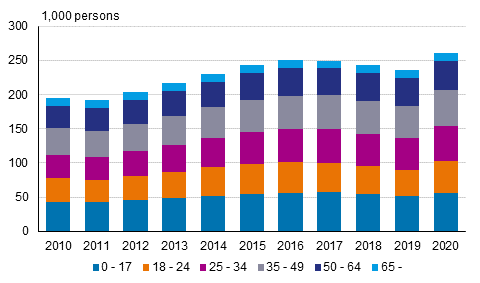Published: 16 December 2021
Number of persons at risk of poverty fell in 2020
The number of persons at risk of poverty decreased in 2020. There were 678,800 persons at risk of poverty, or 12.5 per cent of the dwelling population. One year previously, the number of persons at risk of poverty was 721,100, or 13.4 per cent of the household-dwelling population. The data are based on total data of Statistics Finland's income distribution statistics.
Number of all persons at risk of poverty and number of children at risk of poverty in dwelling population 2010–2020

Income concept: equivalent disposable monetary income (incl. capital gains) of household dwelling-unit. Source: Total data of income distribution statistics
The number of children at risk of poverty was 114,300 in 2020, while one year earlier it was 128,100. The share of children at risk of poverty among all children decreased from 12.4 to 11.1 per cent. The risk of poverty decreased most among children aged 0 to 3, from 15.4 to 13.4 per cent.
The risk of poverty decreased in all other age groups except among people in their 20s. The at-risk-poverty rate of persons aged 20 to 23 grew from 33.3 to 35.1 per cent. In relative terms, the risk of poverty decreased most among persons aged over 80. The risk of poverty among the oldest age group, those aged 88 or over, decreased by 3.5 percentage points. Despite the decrease, the at-risk-of-poverty rate of the age group is highest after young people, 26.9 per cent. – Age group-specific at-risk-of-poverty data are available in the database table of the income distribution statistics.
At-risk-of-poverty describes the relative income differentials of medium-income and low-income groups, so the development of risk of poverty depends not only on the income development of low-income household-dwelling units, but also on the development of median income. In relative terms, persons are classified as being at risk of poverty if the household-dwelling unit's disposable monetary income per consumption unit 1) is below 60 per cent of the median income of the entire household-dwelling population in the year in question.
The median for household-dwelling units' disposable monetary income (incl. capital gains) was EUR 26,227 per consumption unit in 2020, while one year earlier it was EUR 26,180 (in the value of 2020 money). A household-dwelling unit was recorded as being at risk of poverty, when its income was at most EUR 15,736 per consumption unit in 2020.
In earlier years, sample-based data have been used as the primary data source for the risk-of-poverty publications of the income distribution statistics. However, the latest data on persons at risk of poverty will in future be primarily based on total data. The total data enable examination of risk of poverty on more detailed population group and area levels than the sample data. The total data are also the main data source in national use for describing income differentials. The change harmonises the overall picture formed by income differentials.
Sample-based data on risk of poverty and their long time series with different income concepts are, however, still available from the database tables of the income distribution statistics. The data of the sample are also internationally comparable. The number of persons at risk of poverty calculated from the sample data also decreased in 2020, amounting to 594,000 persons, or 10.9 per cent of the household-dwelling population.
More people completely dependent on basic social security than in the year before
The number of those completely dependent on basic social security grew in 2020. There were 261,500 people completely dependent on basic social security, while one year earlier their number was 235,400. Of children, 56,200 were completely dependent on basic social security, while the figure was 52,000 one year before. Of the household-dwelling population, 4.8 per cent were completely dependent on basic social security and 5.5 per cent of children in 2020. Those completely dependent on basic social security are persons whose household-dwelling unit's gross income consists of over 90 per cent of basic social security benefits. More information about those dependent on basic social security is available from the database tables of the income distribution statistics.
Number of persons completely dependent on basic social security by age 2010–2020

Basic social security benefits comprise basic unemployment allowance and labour market support for unemployment security (incl. integration support), sickness and parental allowances, child home care allowance, child maintenance allowance, child benefits, old-age pensions, disability pensions and survivors' pensions paid as national pensions, guaranteed pensions (2011-), the Social Insurance Institution's rehabilitation allowance, disability allowances, housing allowances, social assistance, study grants and certain other social allowances (e.g. military allowances).
1) The consumption units are based on the so-called OECD's modified scale. One adult in the household-dwelling unit or household is one consumption unit. Other persons aged at least 14 each are 0.5 consumption units and children aged 0 to 13 each are 0.3 consumption units. A household/household-dwelling unit with one adult member is one consumption unit, while a household consisting of spouses and one child aged under 14 together are 1.8 consumption units.
Source: Income Distribution Statistics 2020, Statistics Finland
Inquiries: Kaisa-Mari Okkonen 029 551 3408
Head of Department in charge: Hannele Orjala
- Tables
-
Tables in databases
Pick the data you need into tables, view the data as graphs, or download the data for your use.
Updated 16.12.2021
Official Statistics of Finland (OSF):
Income distribution statistics [e-publication].
ISSN=1799-1331. Income differentials between population subgroups 2020. Helsinki: Statistics Finland [referred: 18.12.2025].
Access method: http://stat.fi/til/tjt/2020/03/tjt_2020_03_2021-12-16_tie_001_en.html

